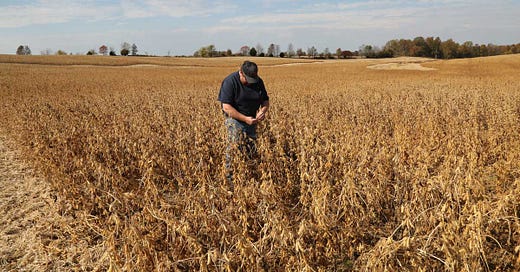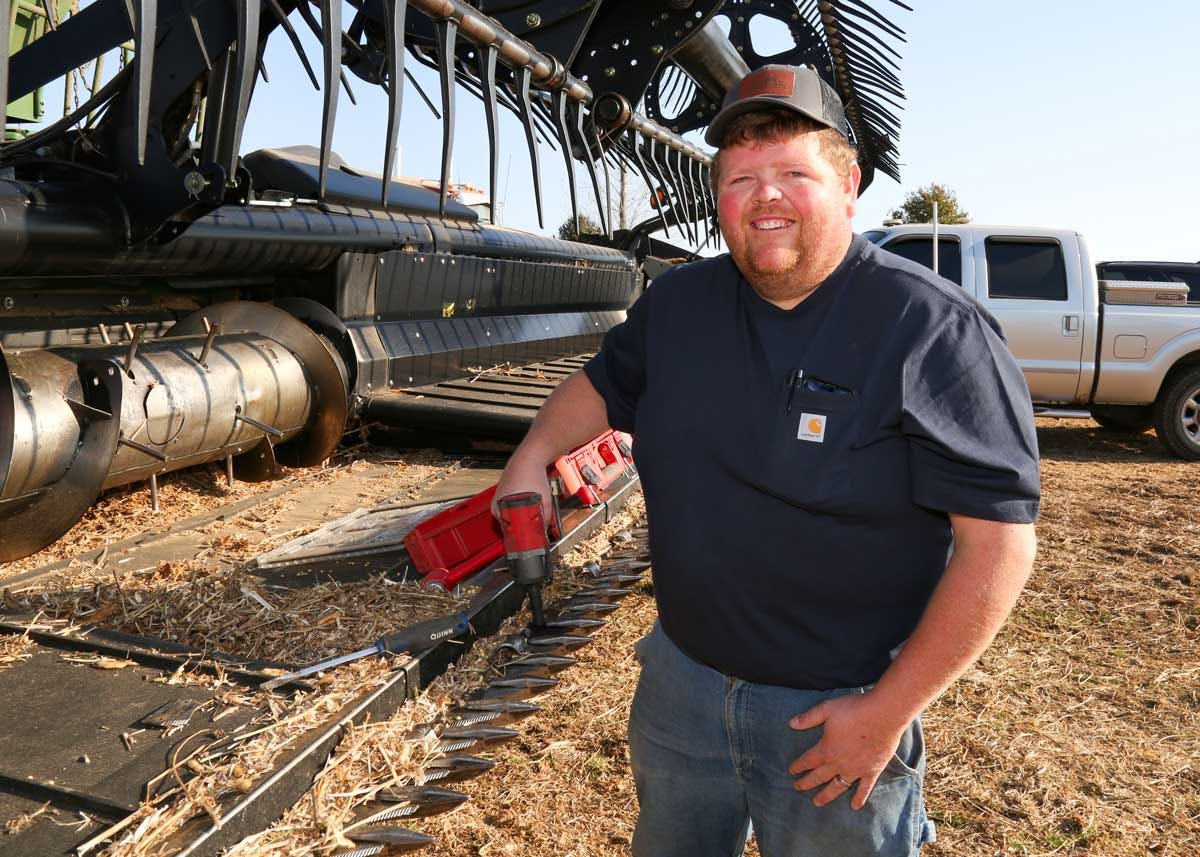
The Free Press

This week, amid an escalating trade war, President Donald Trump announced a 125 percent tariff on China while the country hit back with an 84 percent tariff of its own. This came as a devastating blow for soybean farmers, because China is their top foreign market. In 2024 alone, more than half of all U.S. soybean exports went to China.
Many soybean farmers have been here before. After Trump imposed tariffs back in 2018 during his first term, U.S. agriculture lost $26 billion—nearly $20 billion in soybeans alone. But Trump also emerged from that first trade war with a deal that many farmers celebrated. In fact, many crop farmers in the American heartland helped reelect him in overwhelming numbers.
Caleb Ragland, 38, from Magnolia, Kentucky, who comes from a long line of farmers stretching back 200 years, is one of them—having voted for Trump in 2016, 2020, and 2024. Still, as the president of the American Soybean Association—representing 500,000 soybean farmers across the country—he is deeply concerned about how tariffs will impact him and his colleagues.
In an urgent plea below, he asks President Trump to secure a deal with China, and save the future of farming in America.
My family has been farmers for nine generations, going back to 1808 when my great-great-great-great-great-great-grandfather cut down trees to build a cabin and barns for livestock, and planted the food they needed to survive.
I can see their gravestones from my home here in Magnolia, Kentucky. My father and grandfather taught me to farm and now I’m paying it forward to my three sons, ages 14, 12, and 9.
In the 1980s, farmers in my area shifted from dairy and tobacco to soybeans as new technology changed the market and made it possible to farm rougher terrain and use pesticides to kill weeds without killing crops. But now, because of the trade war with China, I’m worried we could be out of business by 2027. All that history, heritage, blood, sweat, and toil could vanish with the stroke of a pen.
Soybeans are one of the most versatile crops in the world. They have thousands of uses: They can feed cattle, be turned into biofuel and rubber, and be mined for the seed oils that are used throughout the food industry. Last year, soybeans were the number one row crop in my home state of Kentucky. But as I’m planting seeds this spring, I’m facing fear and uncertainty about who will buy my crops come harvest time in October.
The U.S. became the leader in soybean production about 30 years ago. That’s when China started buying our soybeans as it went through its own industrial transformation, making its people wealthier. With more money to spend, the demand for meat exploded—and so did the need to feed soybeans to poultry, cattle, and pigs in China. To this day, they still use 70 percent of their soybean imports to feed livestock.
Soybean production is a year-round affair. In the spring we prepare the soil, plant seeds, and constantly weed the fields. After fall’s harvest, we put the soybeans on semitrucks and drive them to grain handlers, known as “elevators,” on the river or rail stations. My closest elevator is 100 miles from my house, on the Ohio River. Some of the soybeans are crushed and divided into soybean meal and soybean oil. From there, about half is kept in the U.S. and sold to American buyers; the other half is loaded onto barges and floated down the Mississippi River, where it will be loaded onto ships and sent on a monthslong voyage around the world. Last year, 52 percent of U.S. soybean exports went to China, around a fifth to the European Union, and the rest to other places like Japan, South Korea, and Mexico. Right now, soybeans are around $10 a bushel but just three years ago, they were $17 a bushel.
Some say we should aim to sell all our soybeans domestically. But to do that, we would need to double the markets that we currently have in the U.S. That’s just not going to happen at the snap of a finger. It would mean doubling the U.S. consumption of pork, poultry, and beef as well as biofuel production.
Like many of my fellow farmers, I voted for President Donald Trump in the past three elections. The president won me over with his commitment to business-friendly tax cuts as well as his track record of reducing regulation and cutting government spending.
Back in 2018, President Trump negotiated a trade deal with China that would have been very good for our farmers. We had one problem, though, that derailed its effectiveness: Joe Biden. The Phase One deal went into effect in 2020, but when Trump lost the election, President Biden refused to enforce it.
This afternoon, President Trump announced that he would pause retaliatory tariffs on countries willing to negotiate. To me, this is a sign of the president’s good faith. The 125 percent tariff on China still holds, but Trump’s making it clear: They can still come to the table and walk away with a deal that benefits both countries.
It is urgent that a deal happens. The farm economy is much weaker now than it was in his first term. After the first trade war, we lost nearly 10 percent of market share to China that we never regained. The Biden administration made no effort to enforce the deal’s trade targets or advance U.S. agricultural interests. And rising inflation and the costs of production haven’t helped. We farmers have less working capital and less of a cushion to fall back on these days.
The longer the stalemate continues, the likelier China is to take its business elsewhere—like Brazil, for instance, which could bring an additional 70 million acres of land into agricultural production by cutting down rainforests and converting degraded pastureland. Already, they’re working on this; it may take them only months. If I were a gambler, I’d bet that Brazil could have more land and production faster than we can dramatically increase our domestic demand.
Many American farms are multimillion-dollar businesses. The costs of land, fuel, equipment, storage, labor, and insurance are currently around $600 per acre. That means for a farm with 1,000 acres, it costs $600,000 to put the crop out. Most farmers rely on bank loans for capital. But with increased risk comes increased interest rates.
I am one of the 500,000 soybean farmers in America who feels the pain. I rely on my own farm for 100 percent of the income for my family and the families of our three full-time workers. We have 1,500 acres of soybeans on my farm. At $600 an acre, our production costs are $900,000. But in the current climate, an acre brings in only $500 of revenue, which means we’re yielding $750,000—a $150,000 loss.
This year we’re hoping to hang on with a loan to cover the difference. But not every farmer is so lucky. I’ve watched my fellow farmers, who were already having difficulties, forced to have auctions and sell their farms. Some have had to declare bankruptcy and take whatever work they can get as farmhands.
Most farmers can’t afford any more losses. In the most basic sense, we’re being asked to pay to go to work. That means taking on debt that will take years—and good years at that—to recover from.
This shouldn’t concern only farmers, but all Americans.
The agriculture and food industries support over 34 million American jobs—from seed and fertilizer retailers to agronomists who help farmers make the best financial decisions—and contribute $1.5 trillion to the economy. But it’s also the lifeblood of the American heartland.
As a businessman, President Trump must know how urgent this is. The current trade war with China is a gamble with American livelihoods, especially for farmers—those of us who grew up with soil and sweat—who can’t imagine doing anything else.
Mr. President, I hope you hear our plea: Please make a deal with China now.






